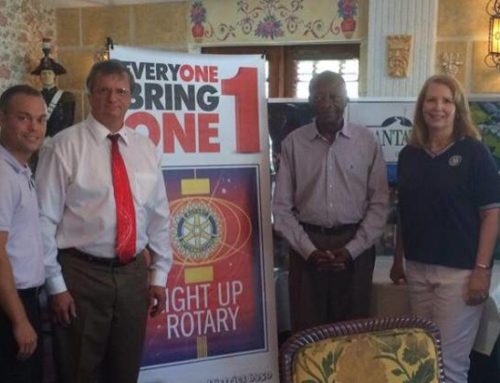In an effort to promote global development and volunteer service, Rotary and Peace Corps have agreed to participate in a one-year pilot program in the Philippines, Thailand, and Togo.
Under the agreement, Rotary clubs and Peace Corps volunteers are encouraged to share their resources and knowledge to boost the impact of development projects in these three countries.
Opportunities for collaboration include supporting community projects, training, networking, and community education. Through the Peace Corps Partnership Program, Rotary clubs can continue to provide small grants to support volunteers and their communities.
Peace Corps Acting Director Carrie Hessler-Radelet and Rotary International General Secretary John Hewko signed the letter of collaboration on Monday, 5 May, at Rotary’s headquarters during a ceremony that was attended by RI President Ron Burton and RPCV Rotary staff. In his remarks to the audience, Burton applauded the collaboration and both organizations’ commitments to service.
“Today’s announcement is particularly meaningful for me because I come from a family of Rotarians,” said Hessler-Radelet, referring to her father, grandfather, and aunt. “We are eager to join together in common efforts to inspire volunteerism across the country and around the world.”
Hewko noted how both organizations are committed to improving lives and building stronger communities by addressing the root causes of violence and conflict, such as poverty, illiteracy, disease, and lack of access to clean water and sanitation.
The two organizations also agreed to explore expanding the collaboration to more countries based on the results of the pilot. Rotary will enlist the support of its members in recruiting Peace Corps volunteers and involving returned Peace Corps volunteers in service projects at home.
ROTARY MEMBERS MADE COLLABORATION POSSIBLE
Hessler-Radelet credited Rotary members in the Denver area, particularly returned Peace Corps volunteers Sue Fox, Valerie Hopkins, and Steve Werner, with helping to make the collaboration possible.
The three Rotarians, who attended the signing, are members of the District 5450 Rotary-Peace Corps Alliance Committee, which has sought a formal agreement between the two organizations since 2010.
Werner said they wanted to create an official relationship to make it easier for Rotary clubs and Peace Corps volunteers to connect. “[The letter] ensures compatibility and a shared value system,” he added.
Jesse Davis, one of more than a dozen Rotary employees who are returned Peace Corps volunteers, said he hopes the partnership inspires more like it around the world.
“While serving as a Peace Corps response volunteer in Panama, I found myself working with the local Rotary club on countless occasions. They were an integral partner in my work,” he said.
STRENGTHENING CONNECTIONS
The letter of collaboration not only officially recognizes the partnership between the two organizations, but also encourages Rotary clubs and Peace Corps volunteers to expand the connections already in place.
In Togo, Peace Corps volunteers Daniel Brown and David Gooze have teamed up with Rotary and other partners in the United States and Togo to distribute more than 5,000 soccer balls to disadvantaged youth. They are organizing ‘More Than Just a Game’ sessions, which use soccer as a medium to teach children about malaria prevention.
“It’s just one example of how Rotary and Peace Corps can collaborate on the ground to achieve lasting impact in the communities where we work,” Hessler-Radelet said.
Within the Philippines, Thailand, and Togo, Peace Corps posts and Rotary districts will coordinate at the country level with support from the headquarters of both organizations. Local Rotary clubs interested in working with Peace Corps volunteers should contact their district governors. Clubs located elsewhere should work through their Rotary counterparts in the pilot countries.
By Maureen Vaught
Rotary News
6-MAY-2014

